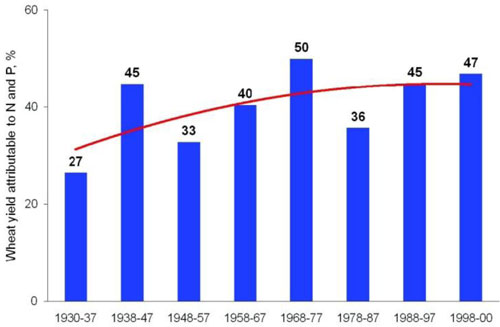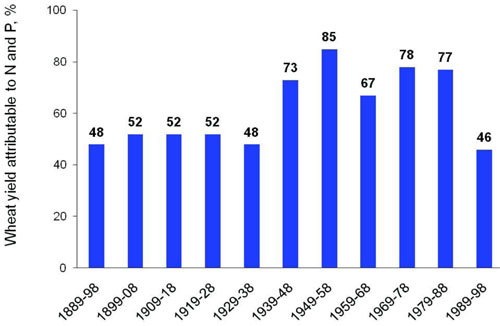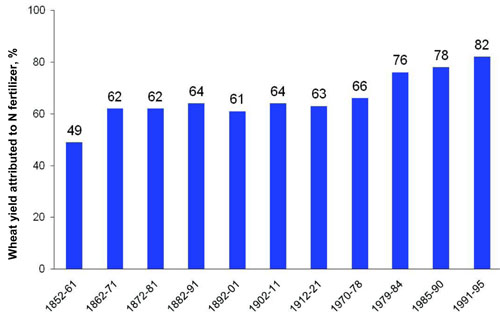Challenges to feeding the seven billion and beyond – Part 3: Role of fertilizers
Commercial fertilizer accounts for 40-60 percent of cereal food production. Best management practices that utilize fertilizer more efficiently and effectively are critical for profitability and environmental stewardship.
Food security is one of the greatest challenges facing humanity. The world population is projected to increase from its current seven billion to nine billion people in 2050. Agricultural production will need to almost double at that time. The vast majority of this population growth will occur in developing countries, especially in South Asia and Sub-Saharan Africa, regions that are familiar with poverty issues and subsistence agriculture. Much of the growth will also occur in urban areas, where most people buy food and not grow it. The global challenge would be to satisfy this unprecedented increase in demand for food, fiber, animal feed and biofuel. Farmers worldwide will be expected to grow crops and raise livestock under conditions of rising input costs, scarce natural resources, stricter environmental regulations and climate change.
Several long-term studies in the United States and United Kingdom have established that the percentage of wheat yield attributable to fertilizer ranged from about 40 to 60 percent (Figures 1-3). This data from three separate locations demonstrate the contribution of the three macronutrients, N, P and K fertilizer on crop yield over check plots that received no fertilizer. In the tropical slash-and-burn agriculture systems, the contribution of fertilizer would be even greater because the soil nutrients are virtually depleted after a few years of cultivation.

Figure 1. Wheat yield attributable to N and P fertilizer in the Oklahoma State University Magruder plots, 1930-2000 (Stewart et al., 2005). Average increase = 40%.

Figure 2. Wheat yield attributable to fertilizer, in the University of Missouri Sanborn Field plots, 1889-1998 (Stewart et al., 2005). Average increase = 62%.

Figure 3. Wheat yield attributable to N fertilizer with adequate P and K compared to P and K alone in the Broadbalk experiments in Rothamsted, U.K -1995 (Stewart et al., 2005). Average increase = 64%.
By increasing yield per unit area, the synthetic fertilizers will spare millions of acres of natural and ecologically sensitive land that otherwise would have to be converted to agriculture in the future. It is quite logical to expect commercial fertilizers to play a critical role towards achieving the production targets and global food security. It is imperative, however, that this intensified production be achieved without sacrificing the ecological integrity of the food system. To this end, the development of fertilizer best management practices is paramount. One such example would be the implementation of International Plant Nutrition Institute-initiated 4R Nutrient Stewardship Practices that focus on the right rate, right source, right placement and right timing on a site-specific basis.
Another factor that will massively contribute towards increased food production is the advancements in genetics and biotechnology. Some corn seed companies are estimating a 3 percent annual rate of increase in genetic yield potential. Yield increases resulting from improved genetics cannot be taken for granted. At this rate, nutrient consumption by crops and removal by grain will also increase substantially. The production system needs to evolve with integrated use of nutrients, water, pest management, tillage and other cultural practices.
In developing countries, fertilizer availability and affordability are critical to increasing agriculture production. Most of these countries rely on fertilizer imports, but developing good infrastructure and logistics will ensure that fertilizer is available at the time of need. Some countries are proactively offering subsidies or loans to farmers towards fertilizer purchases. Strong extension and outreach programs for farmers promoting optimum fertilizer practices are being initiated through government and private partnerships and aid programs. As high as 60 to 70 percent of the population in these countries is presently engaged in agriculture as a livelihood. Therefore, creating social conditions that lead to economic independence of farmers is a cornerstone for rural development and self-sufficiency.
As the world’s largest producer, exporter and donor of food, the United States can and will play a significant role in meeting the challenge of feeding the nine billion people through continued exports, agribusiness investments and as a source of technological innovation and financial capital. However, countries that have the potential to increase their own food production should do so responsibly as this will provide the most reliable boost to grow and sustain the world’s food supply. Recycling of nutrients needs to be a key component as well as soil building rotations, healthy nutrition dense food crops and unique crops adapted to specific regions. Since some regions have very productive soils while others have less productive soils, open international trade will remain vital for food export and import in the future.
References:
- Potential Biofuels Influence On Nutrient Use And Removal In The U.S., Paul E. Fixen
- The Contribution Of Commercial Fertilizer Nutrients To Food Production, W.M Stewart et al.
- The Role Of Fertilizer In Growing The World’s Food, T.L. Roberts
Read the rest of this series:
- Challenges to feeding the seven billion and beyond – Part 1: Food production strategies
- Challenges to feeding the seven billion and beyond – Part 2: Role of Scientific innovation
- Challenges to feeding the seven billion and beyond – Part 4: Global Food Security Index
- Challenges to feeding the seven billion and beyond – Part 5: GFSI and prospects for improvement
If you are interested in learning more about the 4R Stewardship Practices and nutrient management, please attend the Michigan State University Extension Soil Academy on Sept. 11, 2013. View the program brochure and register online or by mail.



 Print
Print Email
Email


